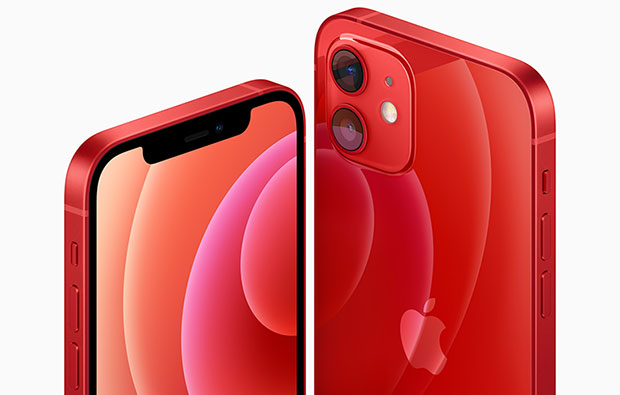Apple refreshed its iPhone product line Tuesday, introducing four new models, as well as a downsized version of its HomePod smart speaker.
All of the new iPhones are built around Apple’s blazing fast A14 Bionic chip, support all flavors of 5G wireless connectivity, and are protected by a Ceramic Shield that protects the phone from damage after a fall four times better than in previous models.
“The Ceramic Shield may sound trivial to some people, but when you can improve the drop test performance of a smartphone by 4x, that’s not a trivial achievement,” Mark N. Vena, a senior analyst at Moor Insights & Strategy, told TechNewsWorld.

The big news from the event, though, was Apple finally making iPhones that support 5G.
“This marks the start of a new era for iPhone,” Apple CEO Tim Cook said at a virtual online event announcing the new products.
Bringing 5G to the iPhone is a huge moment for the product, he noted.”5G will bring a new level of performance for downloads and uploads, higher quality video streaming, more responsive gaming, real time interactivity and so much more,” Cook proclaimed.
“5G networks are more advanced with lower latency and less network congestion so you can get higher network speeds even in densely populated areas,” he continued.
“And 5G even helps protect your privacy and security,” Cook explained, “since you won’t need to connect to unknown, unsecured public Wi-Fi hot spots as often.”
Future Proofing iPhone
Apple is coming to the 5G table after many of its rivals have been eating there for some time. “Apple couldn’t hold off on 5G much longer, despite the varying degrees of 5G availability and performance” said Gerrit Schneemann, a principal analyst at Omdia, a research and consulting firm based in London.
“Some markets, like the U.S. and China are heavy into the 5G cycle now,” he told TechNewsWorld. “China is an important market for Apple so not having 5G handsets is probably not the best position for them to be in.”
All the new iPhone models support both flavors of 5G: sub-6 GHz and mmWave. “They’re future-proofing their lineup,” Schneemann said. “They’re setting up those devices to be in the market for quite some time and support 5G in the market whenever and wherever it becomes available.”
The four new models introduced by Apple are:
- iPhone 12 mini, with a 5.4-inch display (US$699)
- iPhone 12, with a 6.1-inch display ($799)
- iPhone 12 Pro, with a 6.1-inch display ($999)
- iPhone 12 Max, with a 6.7-inch display ($1,099)
The 12 and mini (pictured above), which will be offered in white, black, blue, green and (Product) Red, can be pre-ordered on Oct. 16, for shipment Oct. 23. The Pro and Max, which are offered in graphite, silver, gold and Pacific blue, can be pre-ordered Nov. 6, for shipment on Nov. 13.

The iPhone mini is likely to get a lot of consumer attention. “There’s been tremendous pent-up demand for a high-quality iPhone in a smaller form factor,” said Tim Bajarin, president of Creative Strategies, a technology advisory firm in Campbell, Calif.
“And then when you add 5G and a really good camera imaging system for $699, the mini will be a big hit,” he told TechNewsWorld.
Gunning for DSLRs
All the models have 12-megapixel front and back camera systems. The 12 and mini have dual systems on the back with Ultra Wide (f2.4) and Wide (f1.6) lenses. The Pro and Max have a three-lens system on the back, with ultra-wide, wide and telephoto (f2.2) lenses.
The Pro and Max also have features appealing to professional photographers, such as Apple ProRAW. RAW is a photo format used by professional photographers. ProRAW integrates RAW photography with computational photography to give a photographer greater control of the images they capture.

“Apple is really going after the professional camera market,” Moor’s Vena said. “The things you can do with computational computing are rivaling what you can do with the best DSLR cameras out there.”
“Apple isn’t content making a phone with a really good camera,” he added. “They want to make it your default camera.”
All the phones also support Dolby Vision HDR video. “That’s a really high-resolution professional format,” Vena explained. “Shooting in 4K HDR and Dolby Vision, you will get the same kind of look and feel of a professional movie.”
LiDAR
The new Pro and Max iPhones also have LiDAR scanners. It measures the time it takes for light to travel to an object and travel back. With it, the iPhone can understand its surroundings and build a depth map of it. The technology is a tip-off of Apple’s future plans for the iPhone.
“It’s really important in augmented reality,” explained Bajarin, of Creative Strategies. “In augmented reality apps it creates realistic images and information that sits on top of those images.”

“By bringing LiDAR into the higher end iPhone models, it’s a hint that they’re getting closer to expanding what they’re doing in AR,” he added.
LiDAR can also be used to improve Night mode portraits and focusing faster in low light conditions.
HomePod Mini
In addition to the new iPhones, Apple introduced a smaller version of its HomePod smart speaker.
Like its big brother, the HomePod mini ($99) is wrapped in a mesh fabric created for its acoustic properties. On top of the unit is a backlit touch surface with controls for volume, play and pause, and illuminates when Siri, Apple’s digital assistant, is summoned.
Through the mini, you can play music, get answers to questions, control home devices with your voice and interact with other Apple devices. With multiple minis, you can seamlessly pipe music into multiple rooms and even use them as an intercom system.

“Google and Amazon make small speakers, but they don’t have the quality that I’ve heard in the HomePod mini,” Bajarin maintained.
“I think Apple is being aggressive with the pricing of it, given the quality of the device,” he said.
“Then you add the fact that it connects to every device you use within your Apple ecosystem,” he added. “At $99, it’s just a great buy.”






















































